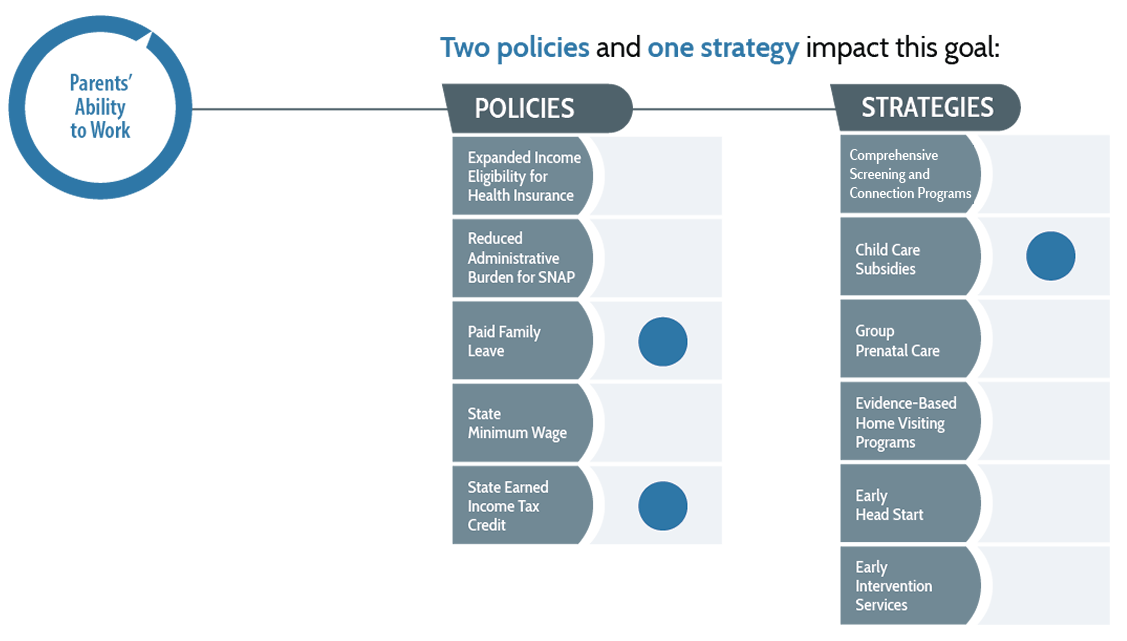
Effective policies and strategies to impact this goal include:
Parents have the skills and incentives for employment and the resources they need to balance working and parenting.

WHY IS PARENTS’ ABILITY TO WORK AN IMPORTANT PRENATAL-TO-3 GOAL?
Irregular and unpredictable work schedules, lack of affordable child care, and limited access to paid time off can compromise a parent’s ability to maintain stable employment and earn enough income to adequately provide for a family. According to data from the National Survey of Children’s Heath, nearly 1 in 10 parents of young children report having to quit, decline, or substantially change a job due to problems with child care.1 For young children in families for whom job instability creates financial hardship, the associated stress on parents can compromise children’s physical and mental health, cognitive development, educational achievement, emotional wellbeing, and social adjustment later in life.2,3,4
Black and Hispanic children are more likely than their peers to experience early challenges associated with job instability. Prior to the collapse of the child care market brought on by the COVID-19 pandemic, unemployment was higher among Black (7.9%) and Hispanic (5.4%) families than among White (4.5%) and Asian (4.1%) families.5 The pandemic and economic downturn perpetuated these disparities; in June 2020, unemployment rates among Black (15.4%) and Hispanic or Latino (14.5%) adults remain higher than those among White (10.1%) adults.6 Although unemployment has fallen to its pre-pandemic rate, the same gaps remain.7
For families with young children, our comprehensive reviews of rigorous research show that states have considerable leverage— through paid sick leave policies, earned income tax credits, and child care subsidies—to remove obstacles to employment and help alleviate the tensions parents experience between working and caregiving. Next is a closer look at these and other solutions states can employ in pursuit of this goal. We also provide information on the percentage of infants and toddlers whose parents have not worked full time within the prior year and how this percentage varies across states. States can use this outcome to measure their progress toward supporting parents’ ability to work.
HOW ARE STATES CURRENTLY MEETING THIS PRENATAL-TO-3 GOAL?
We rely on one outcome measure, parents’ employment security, to illustrate parents’ ability to find and maintain steady employment while also raising a family. Secure employment varies considerably across states, as well as by race and ethnicity.
The outcome measure was calculated intentionally in the negative direction to demonstrate where states have room for improvement and to help states prioritize the prenatal-to-3 policy goals. Out of 51 states, the state lagging furthest behind ranks 51st, and the leading state ranks first. The median state indicates that half of states have outcomes that measure better than that state, whereas half of states have outcomes that are worse. Importantly, the “leading” state on a given outcome does not necessarily indicate a target for all other states to strive toward; even in the states with the best outcomes, many children and families are struggling.
OUTCOME MEASURE: INSECURE PARENTAL EMPLOYMENT
% children under age 3 without any full-time working parent
Median state value: 25.2%
Approximately 26% of children under age 3 have no parent who works full time throughout the entire year, leaving these families economically vulnerable. Children living in the five lagging states are twice as likely not to have a full-time working parent as children living in the five leading states, and Black children are more than twice as likely as White children to have a parent who does not work full time. Hispanic children have rates that are somewhat worse than the US average.

Source: 2019 American Community Survey (ACS) 1-Year Public Use Microdata Sample (PUMS).
Note: Any data marked with an asterisk should be interpreted with caution.
For additional information regarding calculation details, data quality, and source data please refer to Methods and Sources.
For more information on outcomes by goal, including by race and ethnicity and state, see the 2022 Prenatal-to-3 State Policy Roadmap section on outcomes across the US.
WHAT ARE THE MOST EFFECTIVE POLICIES AND STRATEGY TO IMPACT PARENTS’ ABILITY TO WORK?
Based on comprehensive reviews of the most rigorous evidence available, the Prenatal-to-3 Policy Impact Center identified 11 effective solutions that foster the nurturing environments infants and toddlers need. For each of the five policies, the evidence points to a specific policy lever that states can implement to impact outcomes. For the six strategies, the evidence clearly links the strategy to PN-3 outcomes, but the current evidence base does not provide clear guidance on how states should implement each strategy to positively impact outcomes. Three policies and strategies have demonstrated effectiveness at improving parents’ ability to work.

For more information on the impact of state-level policies and strategies in the prenatal-to-3 period, search the Prenatal-to-3 Policy Clearinghouse for an ongoing inventory of rigorous evidence reviews. To learn more about the impact of effective policies and strategies on the eight prenatal-to-3 policy goals, see the Prenatal-to-3 State Policy Roadmap.
WHAT OTHER SOLUTIONS ARE STATES PURSUING THAT CAN HELP BUILD THE EVIDENCE BASE?
Beyond the policies and strategies proven effective by the current research, states also are pursuing other approaches that hold promise for improving parents’ ability to work; these approaches have not yet accumulated enough rigorous research to enable drawing conclusions on their effectiveness, or the Prenatal-to-3 Policy Impact Center has not yet conducted a comprehensive evidence review for the approach. Other solutions states are pursuing that can help build the evidence base on parents’ ability to work include, but are not limited to:
- Fair work scheduling, which are policies that improve schedule predictability and address related issues, including adequacy of hours, compensation, and opportunities for employee input; and
- Two-generation programs for parental employment, which are services and programs that serve both children and their parents at the same time, aiming to empower parents to secure and retain gainful employment while providing children with support needed for successful early development.
SOURCES
- Novoa, C., & Jessen-Howard, S. (2020, February 18). The child care crisis causes job disruptions for more than 2 million parents each year. Center for American Progress. https://www.americanprogress.org/issues/early-childhood/news/2020/02/18/480554/child-care-crisis-causes-job-disruptions-2-million-parents-year/
- Shonkoff, J., Richter, L., van der Gaag, J., & Bhutta, Z. A. (2012). An integrated scientific framework for child survival and early childhood development. Pediatrics,129(2): e460-e472. doi:10.1542/peds.2011-0366
- Research Policy Brief: The Brain Science of Poverty and its Policy Implications- Institute for Research on Poverty- UW-Madison. June 2019, No. 40-2019
- Barch, D., Pagliaccio, D., Belden, A., Harms, M. P., Gaffrey, M., Sylvester, C. M., et al. (2016). Effect of hippocampal and amygdala connectivity on the relationship between preschool poverty and school-age depression. American Journal of Psychiatry 173, 625–634. doi: 10.1176/appi.ajp.2015.15081014
- Bureau of Labor Statistics. (2019, April 21). Employment characteristics of families. https://www.bls.gov/news.release/pdf/famee.pdf
- Bureau of Labor Statistics. (2020, July 2). The employment situation—June 2020. https://www.bls.gov/news.release/pdf/empsit.pdf
- Bureau of Labor Statistics. (2022, September 2). Labor force statistics from the Current Population Survey: Household data, seasonally adjusted. https://www.bls.gov/web/empsit/cpseea04.htm
